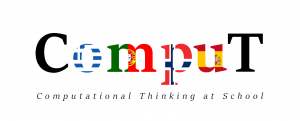Αρχική » Άρθρα με ετικέτα 'approaches to CompuT'
Αρχείο ετικέτας approaches to CompuT
CompuT at IES El Sobradillo, Spain
Computational Thinking by IES El Sobradillo https://youtu.be/awhRzotTT0E
Barefoot Collaborating approach
What is collaborating? Collaborating means working with others and it frequently achieves the best results. Teachers plan together and observe one another to develop good practice. Collaboration motivates us to persevere with tasks which might otherwise seem too confusing or difficult. Computer scientists and software engineers often draw on or improve upon others’ work and […]
Barefoot Persevering approach
What is persevering? Persevering is being determined, resilient, tenacious – never giving up. Albert Einstein said: “It’s not that I’m so smart, it’s just that I stay with problems longer.” Computer programming is hard. This is part of its appeal – writing elegant and effective code is an intellectual challenge requiring not only an understanding […]
Barefoot Debugging approach
What is debugging? Bugs are errors in algorithms and code. Debugging is the process of finding and fixing these and it can often take much longer than writing the code in the first place. There can be errors or in logic and syntax. We can think of errors in logic as parts of a story […]
Barefoot Creating approach
What is creating? Creating is about planning and making things. Some endeavours involve various media each providing an outlet for creative expression. Software and digital media allow scope for creativity and, by mastering software tools and digital devices, we develop confidence, competence and independence which we can use playfully, experimentally and purposefully in the expression […]
Barefoot Tinkering approach
What is tinkering? We often try out something new to discover what it does and how it works: this is tinkering. It’s closely associated with logical reasoning. Pupils build up experiences of cause and effect: “If I move this, then this happens.” It’s a big part of independent learning, without teacher lead. For young children, […]
Visit the website by LTEE
Σύνδεσμος Moodle
eTwinning
Categories
Get ideas
Archive
- Σεπτέμβριος 2022
- Ιούνιος 2022
- Μάρτιος 2022
- Δεκέμβριος 2021
- Οκτώβριος 2021
- Ιούνιος 2021
- Μάιος 2021
- Απρίλιος 2021
- Μάρτιος 2021
- Φεβρουάριος 2021
- Ιανουάριος 2021
- Δεκέμβριος 2020
- Νοέμβριος 2020
- Οκτώβριος 2020
- Σεπτέμβριος 2020
- Απρίλιος 2020
- Μάρτιος 2020
- Φεβρουάριος 2020
- Ιανουάριος 2020
- Δεκέμβριος 2019
- Νοέμβριος 2019
- Οκτώβριος 2019
- Σεπτέμβριος 2019




